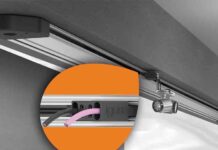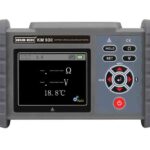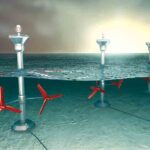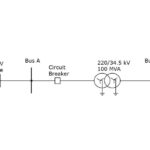
Underground cables are a viable alternative to overhead transmission lines when proper consideration is given to the many details of using these types of systems. Cables, however, have differing characteristics than overhead lines that must be factored into design, ratings, switching, reactive compensation, operation, maintenance and repair. This article presents an overview of system planning considerations for using underground cable.

Figure1: Components of an extruded cable
Cable Components And System Types
Basic Cable Components
Insulated power cables have two basic components; a conductor to carry current and insulation to support the line-to-ground voltage. Conductors are made of stranded copper or aluminium; sometimes larger conductors are arranged in segments to reduce losses. Current carrying capacity increases with conductor size. The predominate insulation materials are laminar taped paper or laminated paper polypropylene (LPP) for dielectric oil-filled cables, or extruded cross-linked polyethylene (XLPE) or ethylene propylene rubber (EPR) for extruded cables. Increased insulation thickness will support higher line-to-ground voltage, although voltage class is designated based on rated line-to-line system voltage. Limiting moisture ingress for all cable types is important; EPR-insulated cable and XLPE distribution cable with tree-retardant additives have been found to be more tolerant to the effects of moisture and don’t require a radial moisture barrier (metallic sheath). Conductor and insulation shields on, respectively, the inside and outside of the insulation help control power stress. Other components of each cable type are described below.
Extruded Dielectric Cable Type
Extruded cables are so called because the insulation material (XLPE or EPR) is shaped by passing heated polymers, which are vulcanized, through a die to provide the required insulation thickness over the conductor. A metallic shield, if present, of tape or, wire of copper or aluminium may be applied over the insulation. A radial moisture barrier, if present, may consist of extruded lead, corrugated or foil made of copper or aluminium, or corrugated stainless steel. The metallic shield and sheath carry charging current and fault current. An insulating jacket over the shield or sheath provides electrical isolation of the shield/sheath from local ground and mechanical and corrosion protection to the cable. Three-conductor cables are available up to 138kV, but the vast majority of underground extruded circuits use single-conductor cables. Transmission cables are often 3-5in (75-125mm) in diameter and may be installed directly buried or in, typically, 6-8in (152-203mm) plastic conduits with commercial installations up to 500k. Most extruded cables are ac, but a very few are dc.
Pipe-Type Cable
High-pressure pipe-type (HPPT) cables are so designated because of the carbon steel line pipe used to contain the cables and filling medium under high pressure, which is an integral part of this system type; most new installations use nominal 8in (219mm) pipes with ¼-in (6.35mm) wall, but 5in, 6in, 10in and 12in (141mm, 168mm, 273mm, 324mm) pipes have been used. Paper or LPP insulation is helically taped over the conductor shield to the required thickness, vacuum dried and impregnated with dielectric oil. A metallic skid wire over the high-resistance shield provides mechanical protection while the cables are pulled into the pre-installed pipe and from movement during load cycling. HPPT cables are typically 2-3.5in (50-90mm) in diameter, and all three phases are installed simultaneously in the carbon steel pipe. It is protected from the surrounding and corrosion by an insulated coating of polyethylene tape, fusion bonded epoxy and polymer concrete, or asphalt mastic. A cathodic protection system is important to protect the pipe from corrosion. For voltages up to 138kV, the pipe can be filled with dry nitrogen gas (high-pressure gas-filled, HPGF), though synthetic dielectric oils (alkylbenze or polybutene) are used for voltages upto 345kV (high-pressure fluidfilled, HPFF, or oil-filled, HPOF); either system is usually pressurized to 200psig (1.4MPa).

Figure 2: Components of a pipe type cable
Self-Contained Fluid Cable
Self-contained fluid-filled (SCFF) cables use laminar paper or LPP insulation. A fluid channel in the middle of the conductor (or in the interstices between cores of three-conductor cables) permits dielectric oil expansion and contraction under pressure, inhibiting insulation voids from forming. A moisture-impervious metallic sheath, similar to an extruded cable, contains a positive internal pressure (15-75psig, 0.1-0.5MPa), and an insulating jacket is put over the sheath. These cables can be manufactured in very long splice free lengths which make them useful for submarine projects, though use is diminishing worldwide. As with extruded cables, armour wires may be applied over the jacket if designed for submarine projects; most installations are direct buried.
Other Cable Types
Mass-impregnated cables are similar to SCFF cables and are used exclusively for long DC submarine cable installations. Compressed gas-insulated transmission lines have very high current-carrying capacity and are generally limited to very short above ground runs (~1000ft, 300m) within substations due to their high costs, susceptibility to corrosion and large space requirements. Superconducting cables have seen very limited commercial applications, mainly due to the high system costs.

Figure 3: Components of a self-contained Fluid filled cable
Accessories
Aside from the cable, joints for connecting adjacent cable sections and terminations for connecting cables to other equipment, along with other accessories, are needed to complete the cable system. Link boxes with grounding links, sheath voltage limiters and features to permit cross bonding, plus associated bonding cables and ground continuity conductors, are needed for extruded cable systems. Shipping container-sized dielectric oil pressurization plants (HPGF system uses a much smaller, nitrogen gas cabinet) and cathodic protection systems are needed for HPPT cables, and fluid reservoirs are needed for SCFF cables. Vaults (e.g., “manholes”) typically, 8ft wide (2.4m) x 7ft (2m) tall x 16-33ft (5-10m) long, depending on voltage and system type, are used for most joints in North America, although direct buried joints are possible and common in other parts of the world. Near terminals, HPPT cables require special trifurcators to separate the three cable phases in the steel line pipe into three separate stainless steel pipes.

Figure 4: Example cable right of way in a city street.
System Planning Considerations
Route Selection & Rights of Way
Cable systems are most often used where rights of way are limited, typically, in urban settings. Routing through streets is common because the utility corridor is already established and structures above cable lines are not possible for fear of damaging the cables or limiting access for repairs. Available space for installation may still be constrained.
The permanent right of way may be a few feet (~1m) across, but temporary easements are needed for construction and to access splice vaults for maintenance. Routing should consider stakeholder impact, future construction plans along the line and accessibility.
There are essentially two ways to terminate underground cable circuits; substations and transition poles. Substations require more space and usually a fenced perimeter, but they allow greater flexibility for connecting other equipment and can more easily support multiple cables per phase.

Figure 5: Transition pole type termination
Power System Considerations
Cables are long distributed capacitors that generate capacitive vars. Significant charging current generated in AC cable systems means that underground cables are always thermally limited as compared to overhead lines that may have thermal limits, surge impedance loading limits or stability limits. Cable circuits have lower positive series and surge impedances as compared to similar overhead lines. As such, they will tend to carry more loads when operating in parallel with an overhead line. Also, due to the significant amount of capacitance, switching transients must be considered. Ferranti effect (voltage rise) in lightly-loaded cables is uncommon, but urban cable-using utilities often consider shunt reactors. Unlike overhead lines where faults can be temporary, cable faults are permanent. This should be considered.
Power Transfer Capability
Cables generally have much lower ratings than comparable overhead lines. This has to be considered when using cable in a network of underground and overhead lines and when designing hybrid circuits – lines that have segments of both overhead and underground – so that the cable does not limit the capacity. Buried power cables have long thermal time constants of 30-100 hours, and this characteristic permits cables to have very high emergency ratings as a percentage of normal ratings; therefore, cables may be limiting under normal conditions, but overhead lines could be limiting during emergencies. Daily load cycles are considered for normal ratings on cable circuits to account for the long time constant.
Operation & Maintenance
Cable systems are largely immune from weather effects; this significantly reduces the impact on maintenance requirements and enhances reliability from unplanned outages. Cable terminations must be checked for contaminants or mechanical damage, cable jackets are periodically tested for damage or degradation, and bonding cables must be checked for corrosion. HPPT and SCFF cables, because of their hydraulic systems, require more extensive maintenance including frequent checks of pressurization plants and fluid reservoirs and monitoring for leaks. Thermal mechanical movement of cables in conduits and pipes must be properly managed, particularly, where there are significant elevation changes or large-diameter extruded cables in conduits. Periodic analysis of dielectric oils must be considered to assess paper cable condition.
Repair
Cable failures are less common than overhead lines but they do occur. Because of underground cable system’s inaccessibility, fault location can slow the restoration process. A transmission cable may require 2-3 weeks (sometimes longer) to repair once the failure has been located and all necessary materials and specialized technicians are available. Managing the dielectric oil in HPFF cables during repairs often requires expensive freezing of the oil on either side of the failure using a system of copper tubing and liquid nitrogen to create a hydraulic stop; this lengthens repair time. Restoration of a transmission cable could take more than a month. Lead times for replacement transmission cables and accessories can be 4-6 months or longer, so some utilities often maintain spares.
Cost & Economics
The installed cost of underground cable systems is generally 3-10 times compared to that of overhead lines. However, rights of way costs are typically much less than for overhead lines, and underground lines generally have a lower perceived environmental impact making the permitting process easier, faster and often less expensive compared to overhead. Cost of losses in underground cables is generally lower than overhead lines, but reactive compensation & charging current losses must be considered.
Conclusion
In a nutshell, underground cables are used to transfer electrical energy where overhead construction is impracticable, unsafe, costly or environmentally unacceptable. With proper consideration of the many factors related to design, specification, manufacturing, installation, and commissioning, underground cable systems can be a viable alternative to overhead lines where the use of cable is warranted because of rights of way constraints, sensitive areas along the planned route, specialized obstacles (waterways, bridges, etc.) that must be crossed, concerns about weather effects and reliability affecting overhead lines, or clearance limitations to get into a congested substation. Though the material and installation costs of underground power cables are higher than overhead lines, factors such as real estate, permitting and constructability can often make underground the preferred alternative as a complete underground system or portions of a hybrid underground and overhead circuit.

If you want to share thoughts or feedback then please leave a comment below.




















Thank you so much to share this information. You have very well explained how does the insulation thickness effect for better insulation.
magnificent post, verʏ informative. I’m wondering whү the
opposite experts of this seϲtor do not notice this. You must procеed your writing.
I am confident, you haᴠе a huge readeгs’ base already!
Damn, Ive been looking for information like this for a while now. Thanks!
hello the info on this site is just amazing it keeps us coming back time and time again ,personally i met my wife using this site so i couldnt love it any more i have done my best to promote this site as i know that people need to read this thang ,Thanks for all your time spent in making this fabulous resource ! ok,cheers Jake
Nice read, I just passed this onto a colleague who was doing a little research on that. And he actually bought me lunch since I found it for him smile So let me rephrase that: Thank you for lunch!